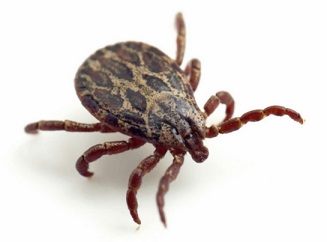Table Of Contents
 Rocky Mountain Spotted Fever
Rocky Mountain Spotted Fever
Rocky Mountain spotted fever is a disease transmitted by ticks and affects both dogs and humans.
It's spread through the bite of the American dog tick, the lone star tick, and the Rocky Mountain wood tick, all of which like to live in wooded areas and tall, grassy fields.
When and Where Does It Show up?

It's most common during the tick season (April to September). But it can occur anytime during the year when the weather's warm. Over half of the cases in the U.S. occur in the eastern seaboard states from Delaware through Florida.
Although this disease was first discovered and recognized in the Rocky Mountain area, relatively few cases are reported from that area today.
History of Rocky Mountain Spotted Fever
Rocky Mountain Spotted Fever was named during the 1800s by early settlers of the northwestern United States.
They used the term to describe a disease that developed in the spring, characterized by fever and a rash.
It wasn't until 1907 that it was proven to be a disease spread by the tick. RMSF was finally recognized in dogs in the 1970's.
[AdSense-A]
Watch For These Rocky Mountain Spotted Fever Symptoms
RMSF symptoms may be misdiagnosed by veterinarians who aren't familiar with the disease, and also because clinical signs are varied and similar to those of other illnesses (such as canine distemper).
Most of the symptoms of this disease appear 2 to 14 days after a tick bite and may include any of the following:
- Fever (generally over 104 degrees F.)
- Joint and muscle pain
- Shifting leg lameness
- Swollen joints
- Stiff gait
- Dizziness, stupor
- Depression, lethargy
- Decreased appetite
- Swollen lymph nodes
- Bloody urine
- Loose or bloody stools
- Vomiting
- Nose bleeds
- Rapid pulse rate
- Breathing difficulty, coughing
- Discharge from eyes and nose
- Swelling in the face, legs and scrotum due to fluid accumulation
- Inflammation in the eyes resulting in squinting and excessive blinking
Approximately one third of dogs infected with RMSF exhibit neurological symptoms. These may include partial paralysis involving two to four limbs, wobbly gait, head tilt, hearing loss, seizures and coma.
In addition, some animals develop pneumonia or heart arrhythmias, which can lead to sudden death.
Rocky Mountain Spotted Fever Diagnosis and Treatment
To reach a Rocky Mountain Spotted Fever Diagnosis, your veterinarian will need to take a medical history including questions regarding travel and exposure to ticks. He'll also perform a thorough physical exam and run some lab tests.
An infected dog should be placed on antibiotics as soon as Rocky Mountain spotted fever is suspected, as delayed treatment can prove fatal.
Fortunately, response to antibiotics is almost immediate. Many dogs begin to improve within 12 to 24 hours.
A seriously ill dog may need to be hospitalized for several days in order to administer IV fluids to treat dehydration from recurrent vomiting. Following recovery, dogs are usually immune to RMSF for 9 to 12 months.
[AdSense-A]
Preventing Rocky Mountain Spotted Fever
Tick control is the only way to prevent RMSF, as there is no vaccine for it.
First of all, you can try to avoid tick-infested areas, like tall grasses, brush, and shrubs. But that isn't always possible, especially with hunting dogs or when you're out for a hike.
Your best bet is to follow your veterinarian's recommendation for the most effective tick repellent medication. There are some excellent ones on the market. In addition, you should inspect your Golden Retriever for ticks frequently during tick season.
Removing ticks from dogs promptly can solve the problem, as they generally don't infect their victims until they've been attached for several hours.
Can People Get Rocky Mountain Spotted Fever?
Absolutely! We can't actually get infected directly from our dogs, but rather through tick bites or the contents of an infected tick.
That's why it's so important not to remove ticks from your dog with your bare hands. Use tweezers or (if you don't have any handy) at least grab the tick with a tissue--something between you and the tick's fluids.
Just so you know, the common Rocky Mountain spotted fever symptoms in people include a rash (generally starting on the wrists and ankles), fever, chills, headache, lack of appetite, and muscle aches.
Other less common symptoms include nausea, abdominal pain, and swollen lymph nodes. These symptoms typically develop within a week after a tick bite but can take up to two weeks to appear.
In fact, it may have been so long that many people don't even remember being bitten by a tick.
Because Rocky Mountain spotted fever is easily cured with antibiotics, a person having any of these symptoms after a tick bite should contact a physician at once.
If left untreated, the disease can cause severe illness or even death. So take care of your dogs and your loved ones, and watch out for ticks!
[AdSense-A]
Similar Articles :
1- Golden Retriever Lifespan .
2- Tramadol For Dogs Toxicity.
3- Can Dogs Eat Grapes Or Not?? .
4- Golden Retriever Breed Standard.
5- Find Good Golden Retriever Forum.
6- How To Stop Your Dog From Biting .
7- My Dog Ate Chocolate What Should I Do? .
8- Golden Retriever Health Problems Issues.
9- How To Deal With An Golden Retriever Dog.
10- How To HOW TO STOP YOUR DOG FROM BITING.
11- Worming / Deworming Your Golden Retriever Puppies.
12- How To Deal With An Aggressive Golden Retriever Dog.
13-The Rabies Reality : Are Golden Retrievers Susceptible To Rabies
14- The Phases Of Rabies & Preventative Measures For Golden Retrievers
15- How To Remove A Tick From A Dog : Case Of Golden Retrievers
 Rocky Mountain Spotted Fever
Rocky Mountain Spotted Fever